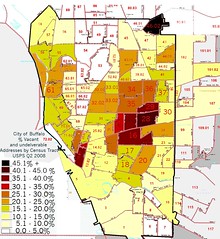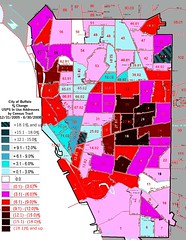I had a chance to catch up with Anthony Armstrong - LISC Buffalo - recently for the latest numbers in what's become the leading indictor of vacancy and abandonment here in Buffalo, NY - the quarterly HUD/Postal Service data indicating the trends around undeliverable addresses.
The staggering data sets - see spreadsheet - are clearly depicted here in these two graphics that Anthony has prepared. That spread sheet is organized by census track for Buffalo and includes data on surrounding towns, too. Both pics, representing numbers at the end of the second quarter - June '08 - clearly show what's happening and how the city's neighborhoods are hollowing out. The first pic is the current snap shot and the second shows the changes over a four year period, 2005 - 2008.
Links to Anthony's previous work is available here - Undeliverable and Unbelievable - Unstoppable? - from this past June. If you're a new reader or old, I'd like to know what you think of these trends and what's happening, or not, in your neighborhood.
__________________________________________________________________________The staggering data sets - see spreadsheet - are clearly depicted here in these two graphics that Anthony has prepared. That spread sheet is organized by census track for Buffalo and includes data on surrounding towns, too. Both pics, representing numbers at the end of the second quarter - June '08 - clearly show what's happening and how the city's neighborhoods are hollowing out. The first pic is the current snap shot and the second shows the changes over a four year period, 2005 - 2008.
Links to Anthony's previous work is available here - Undeliverable and Unbelievable - Unstoppable? - from this past June. If you're a new reader or old, I'd like to know what you think of these trends and what's happening, or not, in your neighborhood.
Artspace • BAVPA • Woodlawn Row Houses • fixBuffalo flickr
the creativity exchange • shrinking cities



4 comments:
Won't be too long before you see those dark numbers creep into Cheektowaga.
It is telling that they focus this diagram just on the city instead of the area as a whole. That is a way of saying this is only a city issue that needs to be dealt with by the city
Steel,
Please do not suggest that we find this solely a City issue – your assumption could not be further from the truth. Let me fill you in on just a few points about our regional approach to vacant property reclamation. If you would then like a more detailed understanding of our positions on and solutions for combating the rise of vacancy throughout the region I have many documents and presentations that we can share with you.
Perhaps for starters you should examine the full spreadsheet David has posted to see the trends we have been pointing out that have been developing throughout Erie County over the past 2 ½ years. This is information that we share with local stakeholders and governments across the county as a public service to help them get a handle on the issues that continue to develop, and I can add you to our e-mail list if you would like.
The National Vacant Properties Campaign’s Blueprint Buffalo: Regional Strategies and Local Tools for Reclaiming Vacant Properties in the City and Suburbs of Buffalo (which can be found at least at http://fixbuffalo.blogspot.com/2008/02/city-planning.html, and http://fixbuffalo.blogspot.com/2006/11/getting-smarter-about-decline.html on this site) would also be a good place to start.
LISC was one of three major players, including the UB Regional Institute and the Amherst IDA, in bringing the National Vacant Properties Campaign to town to do its first regional assessment anywhere in the country. This report includes the towns of Cheektowaga, Tonawanda, and Amherst and would have looked at other farther flung municipalities had the resources existed.
Since the report’s release LISC has been working regularly with officials in towns as far from the city as Evans and Angola on pressing vacant property issues they face. We have presented on vacancy and abandonment in our region to the Erie County Association of Governments, the State Legislature, in the halls of Congress, and more. In no instance have we ever suggested that the answer to the regional vacant property crisis is a go-it-alone approach.
LISC continues our consistent presence at the Erie County Distressed Real Property Task Force, continues to work with the County Legislature as they move toward implementation of a Planning Board, and will continue to emphasize the virtues of a county-wide landbank strategy (as seen in Genesee County (Flint), Michigan, and as was passed in Assembly Bill A8059 and Senate Bill S5366 this past session). We will also continue to press for regional strategies in code enforcement, as well as brownfields and greyfield reclamation, and are continually working with UB’s Regional Institute on a Buffalo Niagara Real Property Intelligence Network as advanced by the Blueprint.
If you have further questions about regional approaches to vacant property please do not hesitate to contact me directly at aarmstrong[at]lisc[dot]org.
- Anthony Armstrong
Anthony,
Now, LISC does good work, but I wonder if the work they're doing is only cosmetic. I feel the only way to truly correct the vacancy issue in Buffalo is to address the heart of the matter. There has to be a mechanism set up that works at getting poor families/individuals more wealth, instilling community spirit, teaching/encouraging positive family structures and giving young adults opportunities.
Fixing the root of the problem won't be easy and will likely take a generation. However, not doing so will continue leading towards underachieving schools, high crime, little wealth, vacant neighborhoods and little tax revenue.
Thank you,
Keith
im not completely sold on undeliverable mail being an absolute indicator.
as a student (read very poor) we moved a lot. wealthier folks ~ even lower middle classes ~ own homes, and dont move as frequently. going from apt. to apt., i couldnt imagine the trail of undeliverable mail i left behind.
I would offer, that undeliverable mail is a better indicator of poverty ~ not necessarily vacancy.
Post a Comment